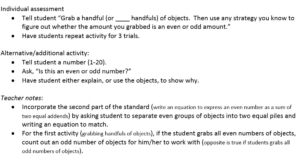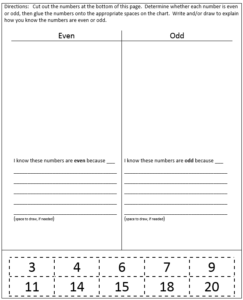MAFS.2.OA.3.3 Determine whether a group of objects (up to 20) has an odd or even number of members, e.g., by pairing objects or counting them by 2s; write an equation to express an even number as a sum of two equal addends.
Cognitive Complexity Level: 2 – Basic Application of Skills and Concepts
[divider] [/divider] Students are able to…
- Use concrete tools to explore which numbers can be divided into groups of 2 with none left over and classify those numbers as even.
- Use concrete tools to explore which numbers when divided into groups of 2 will have one left over and classify those numbers as odd.
- Create equations to show an even number as a sum of two equal groups. Make connections between doubles facts and even numbers; near doubles facts and odd numbers.
[divider] [/divider] Students are able to…because teachers:
- Provide students opportunities to explore numbers and the result when decomposing the value into pairs of two.
- Pose questions to allow students to reason about whether a number is even or odd.
- Facilitate conversation among students about other ways to determine a number is even or odd (double facts/near double facts) and extend student thinking to reasoning about numbers beyond 20.
[divider] [/divider] Questions to ask students:
- Ask: Is 12 even or odd? How do you know?
- Sample answer that indicates understanding: “Even because if you take 12 counters and put them in pairs every counter will have a partner with none left over so it is even” “Even because it can be split into two equal groups 6 + 6.”
- Sample answer that indicates an incomplete understanding or a misconception: Student replies even because it ends in 2. (Ask probing questions to see if student can provide other reasoning)
- Ask: Can you tell me an even number? Can you write an equation to prove that it is even?
- Sample answer that indicates understanding: “20 is even because it can be split into two equal groups 10 + 10 = 20.”
[divider] [/divider] Additional Resources:
Additional in depth content knowledge
Blog Post: Not Just Evens and Odds
http://smathsmarts.com/not-just-evens-and-odds/
Video: Recognize even and odd numbers by forming partners and equal groups
https://learnzillion.com/lesson_plans/6618
[divider] [/divider] Sample Formative Assessment Tasks:
[divider] [/divider] Resources/Tasks to Support Your Child at Home:
- Give your child a number from 0-20. Have your child model that number using some type of counter (cereal, cubes, etc.). Have your child create pairs with the counters. If there are all pairs with no counters by themselves it is an even number. If there are all pairs with some counters left by themselves then it’s an odd number. Continue with all numbers 0-20.
- Use a number chart to look for odd and even number patterns. Have them shade in the odd numbers blue and even numbers red to see the pattern clearly. They should notice that it is every other number that is odd/even.
- Khan Academy: Intro into Even and Odd Numbers

